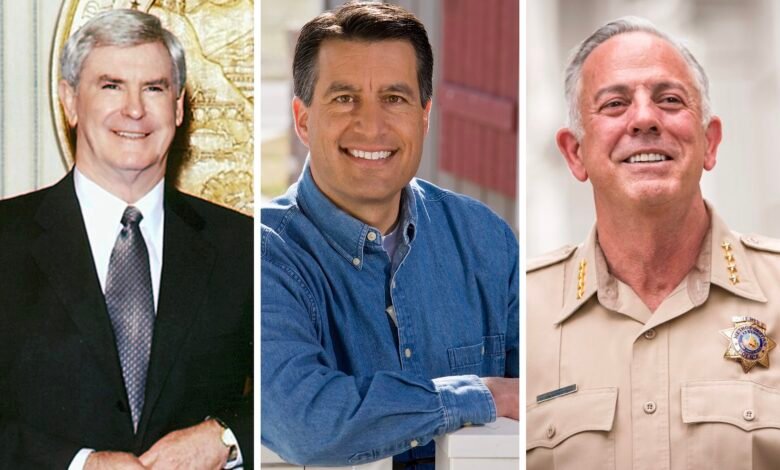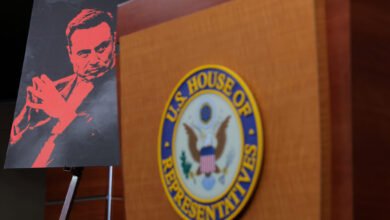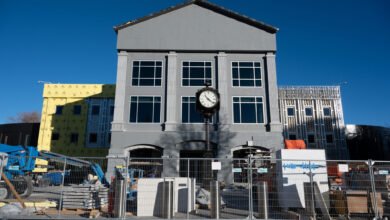Can Nevada Democrats defy their 21st century duodecennial disintegration? • Nevada Current

In 2002, no U.S. Senate seat was on the ballot in Nevada and it wasn’t a presidential election year, so the only thing approximating a high profile race was the one for governor.
And that race was a yawner. All the industries and big shots and their money lined up behind Republican incumbent Kenny Guinn, while the Democratic “Reid machine,” which would one day be celebrated for its might but wasn’t yet, put its muscle behind … no one.
The venerable state Sen. Joe Neal ended up being the Democratic nominee. Neal campaigned on raising the gaming tax, then as now an act of Nevada political sacrilege. Neal was ignored and snubbed by the Nevada State Democratic Party (then-Sen. Harry Reid, proprietor), and Guinn crushed Neal by 46 percentage points.
Twelve years later in 2014, once again no U.S. Senate seat was on the ballot in Nevada and it wasn’t a presidential election year, so the only thing approximating a high-profile race was the one for governor.
And once again that race was a yawner. All the aforementioned industries/big shots/money once again lined up behind a Republican incumbent, Brian Sandoval. The Reid machine, which by 2014 was regarded nationally as one of the most powerful and sophisticated state party organizations in the country, put its considerable sophistication and muscle behind … no one.
Reid had determined there was no animal, vegetable, mineral, or Democrat capable of defeating Sandoval, and Reid feared the reelected and popular Sandoval would run against Reid himself in 2016.
So Reid, who may not have been a policy giant but was an enthusiastic conniver, glommed on to the plan wherein maybe a Democrat could be elected lieutenant governor. That would tie Sandoval to his job as governor and prevent him from running for Senate, since a Sandoval Senate victory would mean Nevada would suddenly have a Democratic governor.
Is there a confluence of events capable of making voters pay attention to and care about the outcome of a Nevada race for lieutenant governor? We may never know. Democratic voters in 2014, even when (or because?) left with little else to vote for, demonstrated no interest in that office or any others on the ballot, and Nevada Republicans won the LG race and pretty much everything else that year.
So Reid’s plan was foiled. Or it would have been, had there been anything to foil. Reid himself opted not to seek reelection in 2016. And Sandoval seemed more than happy to let Republican Rep. Joe Heck vie for the Senate seat being vacated by Reid. (Heck lost to the Democratic nominee, Catherine Cortez Masto).
In 2026 it will have been 12 years since that dopey 2014 debacle. And in 2026 — as in 2014, and as in 2002 a dozen years before that — no U.S. Senate seat will be on the ballot in Nevada and it won’t be a presidential election year.
The only thing approximating a high-profile race, that is, a race that the casual voter might take an interest in, will be the one for governor.
And as in 2002 and 2014, a Republican incumbent will be seeking reelection.
Gov. Joe Lombardo’s got to be loving this column.
But 2026 will differ from 2002 and 2014.
Guinn in 2002 was running against an extremely lightly funded opponent who wasn’t even actively supported by his own party.
Sandoval in 2014 effectively ran unopposed.
Nevada Democratic Attorney General Aaron Ford last month confirmed what a lot of people assumed after he won reelection in 2022 — that he’s planning to run against Lombardo in 2026.
Ford is a proven fundraiser who has won two statewide elections. But hopefully that, combined with an annoying proclivity among the vestige of the Reid machine to grease the skids for machine-picked entrants, won’t deter other candidates from also running in a Democratic primary — and won’t deter donors from contributing to other candidates.
Just because the Nevada State Democratic Party over the years has shown little to no organizational interest in the notion, that doesn’t mean voters don’t deserve choices.
But whether it’s Ford, or anyone who beats Ford, Lombardo will almost certainly be challenged by a politically viable candidacy, something Guinn and especially Sandoval didn’t have to worry about when they were seeking reelection.
The 2026 campaign cycle will be different from the 2002 and 2014 cycles in other ways as well.
In 2002, the nation was whipped into a post-911 frenzy of enthusiasm for Bush-Cheney military aggression. Democrats (including and especially Reid) countered all that fist-pumping and flag-waving by saying “us too.” Their surrender to Republican messaging was so thorough that a month before the 2002 election Reid and other Democrats gave the Bush Administration a blank check to go a war-mongering wherever and whenever it wanted. Democrats nationwide having sheepishly slunk off into corners, Republicans picked up seats in both the House and the Senate in 2002, which was an extreme anomaly because the party of the president almost always gets drubbed in midterm elections.
In 2014, there was no such anomaly. The party (Democrats) of the president (Barack Obama) got drubbed up and down ballots nationwide in a red wave.
In the 2026 midterms, Donald Trump, who purports to be some sort of Republican when it suits him, will be in the White House. Under normal historical patterns that would bode well for Democrats.
The 21st century’s hostility to normalcy however is only getting more bizarre with each passing year. It’s impossible to know what oddity, predicament, or crisis, whether genuine, imagined, or manufactured, will have lodged in the noggins of a critical mass of the voting public by the time Nevada gets to determine if it wants to stick with Lombardo or go in a different direction.
And maybe it’s just in the stars that Nevada Democrats not only lose the governor’s race (which they almost always do), but every 12 years, they don’t even bother to show up for it.
Meanwhile, some of you might be thinking “hold on a minute history dork, we’re like two days into 2025 and you’re nattering on about 2026. Why you gotta be so rude?” Or words to that effect.
Understandable.
Which is why it is with regret to inform you that one month from tomorrow, on February 3, the longest continuous campaign event of the 2026 Nevada election cycle will begin. In other words, the Nevada Legislature will convene for its last general session before the 2026 election.
You may not be thinking about 2026 yet, but Lombardo is.
So are Nevada Democrats, who should hope there is not some mysterious cosmic force that turns them to jello every twelfth time the Earth revolves around the Sun.




